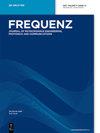设计用于植入式生物医学应用的高增益小型化 WPT 整型天线
IF 1
4区 工程技术
Q4 ENGINEERING, ELECTRICAL & ELECTRONIC
引用次数: 0
摘要
随着生物医学技术领域取得重大技术突破,植入式医疗设备(IMD)已成为治疗各种健康疾病和监测个人健康状况不可或缺的设备。本文介绍了一种针对 IMD 等低功率设备的 2.45 GHz 无线供电技术。该设计采用了矩形贴片天线,其峰值增益为 2.1 dB,阻抗带宽为 620 MHz,体积仅为 71.4 mm3。该天线在一个复制人体的三层幻影模型中进行了模拟,以评估其性能,其峰值增益为 -21.4 dB,阻抗带宽为 600 MHz-10 dB。全波整流器通过匹配网络实现射频信号到直流电源的最佳转换。构建的原型在生理盐水溶液中进行了测试,测量结果与模拟结果非常吻合。使用模型和头部模型计算了比吸收率(SAR),以评估病人的安全性和生物兼容性。拟议的天线在三层人体模型和人体头部模型中的 SAR 值分别为 5.12 W/kg 和 3.13 W/kg。本文章由计算机程序翻译,如有差异,请以英文原文为准。
Design of high gain miniaturized WPT rectenna for implantable biomedical applications
Implantable medical devices (IMDs) have become indispensable for treating various health disorders and monitoring individual well-being as a result of significant technical breakthroughs in the field of biomedical technology. This article describes a wireless powering technique at 2.45 GHz for low power devices such as IMDs. The design incorporates a rectangular patch antenna that exhibits peak gain of 2.1 dB and impedance bandwidth of 620 MHz with compact size of 71.4 mm3 . The antenna is simulated within a three-layer phantom model replicating the human body to evaluate its performance, which produces −21.4 dB peak gain and 600 MHz–10 dB impedance bandwidth. A full wave rectifier aided by matching network is used to accomplish optimal conversion of RF signal to DC power. The constructed prototype is tested in a saline solution, and the measured results closely match the simulation results. Specific Absorption Rate (SAR) is calculated using a phantom model and a head model for assessing patient safety and biocompatibility. The proposed antenna has SAR values of 5.12 W/kg and 3.13 W/kg are exhibited by proposed antenna inside three layer phantom model and human head model.
求助全文
通过发布文献求助,成功后即可免费获取论文全文。
去求助
来源期刊

Frequenz
工程技术-工程:电子与电气
CiteScore
2.40
自引率
18.20%
发文量
81
审稿时长
3 months
期刊介绍:
Frequenz is one of the leading scientific and technological journals covering all aspects of RF-, Microwave-, and THz-Engineering. It is a peer-reviewed, bi-monthly published journal.
Frequenz was first published in 1947 with a circulation of 7000 copies, focusing on telecommunications. Today, the major objective of Frequenz is to highlight current research activities and development efforts in RF-, Microwave-, and THz-Engineering throughout a wide frequency spectrum ranging from radio via microwave up to THz frequencies.
RF-, Microwave-, and THz-Engineering is a very active area of Research & Development as well as of Applications in a wide variety of fields. It has been the key to enabling technologies responsible for phenomenal growth of satellite broadcasting, wireless communications, satellite and terrestrial mobile communications and navigation, high-speed THz communication systems. It will open up new technologies in communications, radar, remote sensing and imaging, in identification and localization as well as in sensors, e.g. for wireless industrial process and environmental monitoring as well as for biomedical sensing.
 求助内容:
求助内容: 应助结果提醒方式:
应助结果提醒方式:


